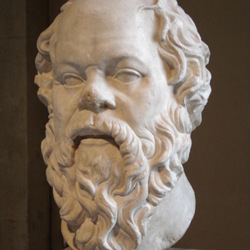Head of Socrates
Title
Head of Socrates
Date
Roman Copy: Unknown,
Bronze Original: mid-4th century BC, Greek Classical Period
Bronze Original: mid-4th century BC, Greek Classical Period
Artist or Workshop
Unknown, Bronze original by Lysippos
Materials
Marble
Height of the work
33.5 cm tall
Provenience
Roman Copy: Unknown
Bronze Original: Pompeion in Athens
Bronze Original: Pompeion in Athens
Current Location
Louvre Museum, Paris
Description and Significance
Description:
The Head of Socrates depicts a face of the great philosopher. It includes the full head and continues down to stop at the neck. The portrait depicts an older man with a receding hairline, curly hair renderings along the sides and back of the head as well as a long pointed beard. The rendering of the hair is very detailed, showing naturalistic patterns and directions of hair flow. The amount of wrinkles on the forehead and cheeks show realistic signs of age, and helps create a very serious and wise undertone for the sculpture. The tip of the nose seems to have been scraped or damaged from either excavation or transportation of the artifact. The almond-shaped eyes are slightly exaggerated. The portrait includes Socrates' distinct receding hairline, silenos-like beard, and slightly open mouth. This portrait of the head was originally meant to be inserted into a larger body, which is now missing. It seems evident that the intent of this piece was to highlight Socrates’ physical display of age and focus as philosopher.
Significance:
The style and appearance of this posthumous portrait stem from the new trend in portraiture following the defeat of the Greeks by the Macedonians at the Battle of Chaeronea in 338 BC. This time period is when sculptors, especially Lysippos, started to really incorporate their model’s personal character, realism, and emotion in to the face of the piece. The eyes create a very starry gaze for the portrait as if it were depicting Socrates in deep thought, or in preparation to make an intellectual statement. It seems evident that the intent of this piece was to highlight Socrates’ physical age and focus as philosopher. The amount of detail that was put into this piece in order to emphasize Socrates’ wrinkled skin, long beard, and focused expression was clearly a structured depiction of his knowledge and wisdom. Having such a visible receding hair line and a long pointed beard were not qualities of the portraits of the young and physically powerful models, such as the Statue of Meleager. The artist of this piece was much more interested in encapsulating Socrates' identity as a scholar. By choosing to emphasize features such as wrinkles and folds that represent having a long life, rather than idealizing the face, it displays that Socrates has probably learned a lot of lessons over the years and was a true man of experience and philosophy.
The Head of Socrates depicts a face of the great philosopher. It includes the full head and continues down to stop at the neck. The portrait depicts an older man with a receding hairline, curly hair renderings along the sides and back of the head as well as a long pointed beard. The rendering of the hair is very detailed, showing naturalistic patterns and directions of hair flow. The amount of wrinkles on the forehead and cheeks show realistic signs of age, and helps create a very serious and wise undertone for the sculpture. The tip of the nose seems to have been scraped or damaged from either excavation or transportation of the artifact. The almond-shaped eyes are slightly exaggerated. The portrait includes Socrates' distinct receding hairline, silenos-like beard, and slightly open mouth. This portrait of the head was originally meant to be inserted into a larger body, which is now missing. It seems evident that the intent of this piece was to highlight Socrates’ physical display of age and focus as philosopher.
Significance:
The style and appearance of this posthumous portrait stem from the new trend in portraiture following the defeat of the Greeks by the Macedonians at the Battle of Chaeronea in 338 BC. This time period is when sculptors, especially Lysippos, started to really incorporate their model’s personal character, realism, and emotion in to the face of the piece. The eyes create a very starry gaze for the portrait as if it were depicting Socrates in deep thought, or in preparation to make an intellectual statement. It seems evident that the intent of this piece was to highlight Socrates’ physical age and focus as philosopher. The amount of detail that was put into this piece in order to emphasize Socrates’ wrinkled skin, long beard, and focused expression was clearly a structured depiction of his knowledge and wisdom. Having such a visible receding hair line and a long pointed beard were not qualities of the portraits of the young and physically powerful models, such as the Statue of Meleager. The artist of this piece was much more interested in encapsulating Socrates' identity as a scholar. By choosing to emphasize features such as wrinkles and folds that represent having a long life, rather than idealizing the face, it displays that Socrates has probably learned a lot of lessons over the years and was a true man of experience and philosophy.
References
The Stoa Consortium
http://www.stoa.org/projects/demos/article_portraits?page=12
Cosmo Learning
https://cosmolearning.org/images/socrates-louvre-museum-paris/
http://www.stoa.org/projects/demos/article_portraits?page=12
Cosmo Learning
https://cosmolearning.org/images/socrates-louvre-museum-paris/
Contributor
Gentry Pack
Citation
Unknown, Bronze original by Lysippos, “Head of Socrates,” Digital Portrait "Basket" - ARTH488A "Ancient Mediterranean Portraiture", accessed June 7, 2025, http://classicalchopped.artinterp.org/omeka/items/show/19.
Item Relations
This item has no relations.

